
2015年全球军工百强榜出炉:美国绝对主导,“中国军工企业至少有9家可以入围”
当地时间12月5日,瑞典斯德哥尔摩国际和平研究所(SIPRI)发布了《2015年度全球军工企业百强榜》。最新统计显示,位居全球前一百强的军工企业(中国除外)在2015年的销售额达到3707亿美元。
根据这份能够反映全球武器贸易市场格局与走势的报告,美国依旧在全球军贸市场占据着绝对的主导地位,但是所占的市场份额继续下降。西欧国家与俄罗斯所占的份额有所提升,新兴军工企业崛起势头明显。
西方国家仍是全球军火市场的绝对主导
报告显示,美国与西欧国家仍在全球军火市场维持着近乎垄断的优势。在销售额上,美欧合计达3054亿美元,占总额的82.4%。在前一百强的榜单中,美欧占据了一半以上的席位,并且垄断了前十名的公司(这十家公司2015年业绩达1914亿美元,占总额的51.6%)。
具体而论,美国以2097亿美元的销售额在2015年继续领跑,占比56.6%,但比2014年2156亿美元的销售额降低了2.9%——这也是连续第五年持续下滑。但需要注意的是,美国军工企业的表现依旧强势,在前十名中占据7席,前一百强中占据39席。
SIPRI武器与军事开支项目主管奥德·弗勒朗(Aude Fleurant)表示,洛克希德·马丁依然是世界最大的武器制造商,美国军火商销售额下降主要是受到美国国防开支削减、主要武器系统采购事宜的延迟(如F-35)、以及美元汇率上升的影响。
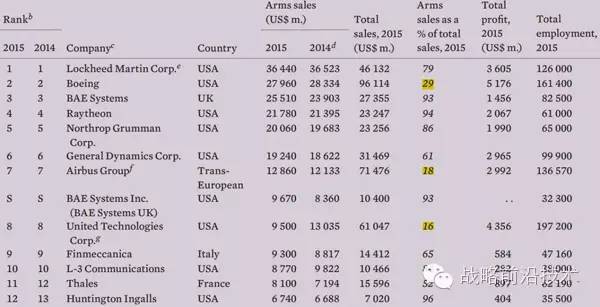
2015年度排名前列的军工企业百强 图片来源:SIPRI《2015年度全球军工企业百强榜》
西欧的军工企业主要集中在法、英、德、意四国,它们在2015年的销售额为957亿美元,比2014年提高6.6%。其中,6家法国公司(尤其是达索航空集团)的业绩达214亿美元,同比提升13.1%,成为西欧所占市场份额扭转下跌趋势的主力。
Fleurant表示,法国公司业绩的显著增长主要依靠对埃及和卡塔尔的出口。据悉,2015年法国四分之三的军备出口面向中东地区,其中最主要的是与埃及和卡塔尔达成的分别向两国出口24架“阵风”战斗机的合同。
此外,英、德、意三国分别有9家、3家和4家公司进入前百强(欧洲多国联合企业除外)。其中,英国BAE系统公司、欧洲空客集团与意大利芬梅卡尼卡集团分列第三、第七和第九位。
俄罗斯维持增长但前景堪忧
根据报告,2015年俄罗斯有11家企业进入百强,并以301亿美元的销售额占据8.1%的市场份额。然而,尽管俄罗斯实现了6.2%的增长,但是增幅却大大低于上年48.4%的水平。
报告认为,俄罗斯政府对国防工业的投资,以及重要的武器出口——主要依靠俄罗斯直升机公司和战术导弹武器集团——促成了俄罗斯军工企业的市场地位。俄罗斯企业的主要盈利(以卢布计算)来自于俄罗斯军队的现代化改革,但是所有俄罗斯企业的排名较2014年都有所下降。
那么,俄罗斯的军工企业能否延续其稳定发展的势头呢?
“这取决于俄罗斯的国防预算和国内通货膨胀的情况。俄罗斯近年来的武器出口额相当稳定,其市场增长主要依赖国防预算的增长。但是随着国际原油价格的下跌以及国内经济的衰退,俄罗斯在未来数年必须对国防开支做出削减。” SIPRI武器与军事开支项目高级研究员西蒙·魏泽曼(Siemon Wezeman)对澎湃新闻()表示。
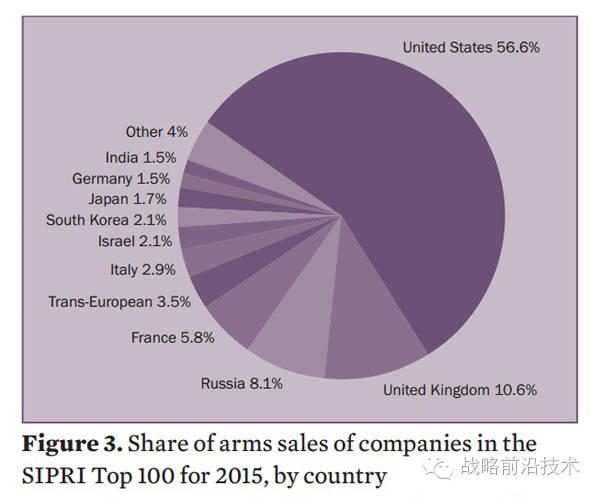
2015年榜单各国占有的军工市场份额 图片来源:SIPRI《2015年度全球军工企业百强榜》
“即便俄罗斯竭力维持国防预算的增长,这份努力也会因严重的通货膨胀大打折扣。” 魏泽曼强调,“俄罗斯还亟需更新过时的生产线,并提高研发支出,否则其出口市场将面临来自中国、以色列、韩国、乌克兰、土耳其等国产品的激烈竞争。”
韩国企业异军突起引关注
报告显示,2015年新兴军工企业正在迅速崛起,冲击着原本由美欧俄主宰的国际军火市场。据统计,以韩国企业为代表的新兴军工企业及其它企业占据了9.5%的市场份额,市值约345亿美元。其中,韩国企业的销售额实现了31.7%的增长,市值达77亿美元。印度和土耳其企业的销售额分别增长了9.3%和10.2%。
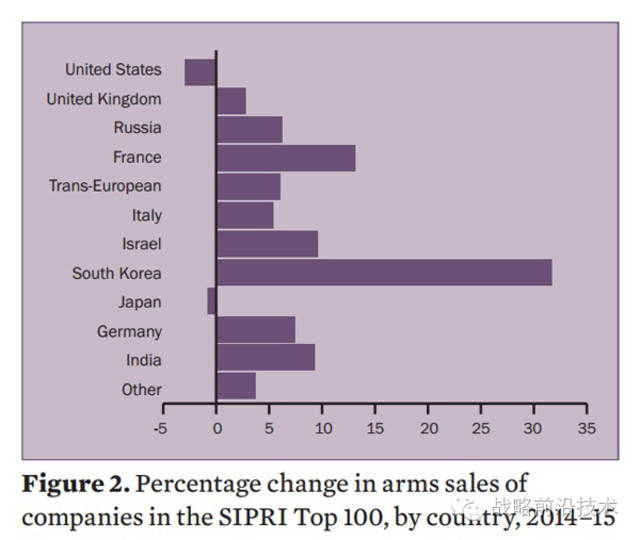
2014-2015年榜单各国武器销售额变动比例 图片来源:SIPRI《2015年度全球军工企业百强榜》
近年来,韩国致力于“国防自主”,投入巨资力求实现主战装备的国产化。例如,韩国通过引进德国214型潜艇的生产技术,在仿制的基础上已经开始自行设计其国产潜艇。在水面舰艇领域,韩国已经实现了发动机、声纳等关键装备和部件的国产化。在航空航天领域,T-50高级教练机和FA-50轻型战斗机已经实现了出口,并参与到美国下一代教练机的竞标。
“韩国军工的崛起主要得益于迅速增长的国防开支和清晰坚定的发展本国国防工业的政策。”魏泽曼认为,“韩国民用高科技的发展也使其国防工业获益良多。”
此次进入榜单的韩国企业包括LIG Nex1、韩国宇航工业、丰山公司、大宇造船和韩华集团。这些防务公司各有特点。在今年9月举行的第二届韩国防务展上,LIG Nex1公司展出了其研制的LEXO液压驱动式军用外骨骼系统,可增强穿戴者的力量和耐力。丰山公司则在弹药与火药领域颇有建树,向全球多国军队供应弹药。
特朗普或扭转全球军火市场下滑趋势
自2002年开始,SIPRI都会发布年度全球军火市场的相关报告。自2011年开始,这一数据已保持了连续五年下滑的趋势。2015年,全球3707亿美元的销售总额相比于上年降低了约0.6%。但是,0.6%的水平也是五年来程度最轻的降幅。报告认为,这可能意味着2016年军火市场走势将逆转近年来下滑的趋势。
“国际安全总体形势的变化可能会促使全球军费开支进一步提升。” 清华-卡内基全球政策中心研究员赵通表示,“随着朝鲜核计划再度活跃,整个东北亚的防务开支还会进一步扩大。另外,美俄关系的紧张、中东战局的绵延都会促使军事开支和武器贸易的增长。”
自今年朝鲜进行两次核试验后,韩国已经做出了引进“萨德”系统和德国“金牛座”对地打击系统的决定,日本也对“萨德”表现出强烈的兴趣。此外,由于美俄在东欧的激烈对峙,双方都在增加前线的军力部署,并配备、试射和研发包括弹道导弹在内的武器装备。
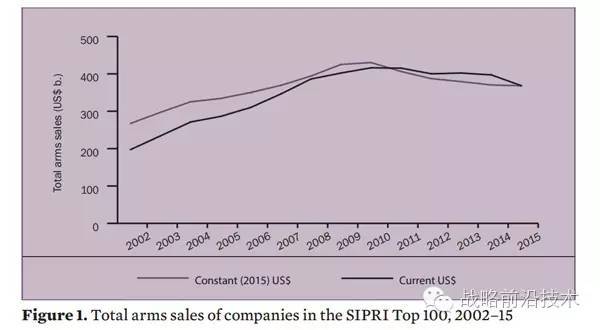
2002-2015年SIPRI军工百强年度武器销售总额 图片来源:SIPRI《2015年度全球军工企业百强榜》
“另一个变量是特朗普的当选。”赵通认为,“尽管特朗普可能进行战略收缩,但其出发点是建立一支更为强大的军队以保卫美国安全,因此美国可能会扭转其防务支出不断削减的趋势,而其盟国的防务支出可能会因特朗普的要求进一步增加。”
据“德国之声”12月2日报道,波恩BICC中心预测,美国候任总统特朗普入主白宫后,北约成员国里的欧洲国家的军费开支可能会有所上升,因为特朗普可能会要求它们兑现各自军费份额承诺,即将GDP的2%用于国防支出。而目前只有5个北约成员国满足这一要求。
此外,“特朗普政府在安全领域的成员与顾问多为共和党的传统支持者,他们与美国军工企业存在许多联系,对增加军事力量和对外军售多持支持态度。”赵通强调,“对其有影响力的智库,如传统基金会,也持类似看法。”
12月1日,特朗普正式提名退役美军上将詹姆斯·马蒂斯为国防部长。据悉,马蒂斯绰号“疯狗”,此前曾多次批评奥巴马政府在中东过于软弱,主张采取更强硬的中东政策,尤其是在阿富汗战争和伊朗核问题上。
但是,魏泽曼认为,尽管美国军工复合体非常希望特朗普的当选能够给它们带去更大的利益,但是特朗普迄今为止尚未明确说明他在国防开支上的预算。而且,尽管国会两院由共和党主导,但是共和党议员们也并非都是特朗普的支持者。
“需要注意,尽管特朗普表达了对军队的重视,但是美国军费占GDP的比重(4%以上)远高于其欧洲和亚洲盟友,这对希望重振美国经济的特朗普来说是一个并不轻松的负担。” 魏泽曼强调。
“至少有9家中国企业可以入围百强榜”
报告最后称,由于缺乏相关数据,所有的中国军工企业并未能列入榜单。但是,通过对中国总体工业情况、以及10家主要军工企业的有限数据的分析,报告认为这10家企业中“至少有9家”可以进入百强榜单。其中,4-6家可能跻身前二十,而中国航空工业集团公司(AVIC)和中国北方工业公司(Norinco)或许可以位列前十。
“中国国内的军品市场非常庞大,而且对外武器出口也在增加。”魏泽曼表示。
2015年11月24日,中央军委改革工作会议拉开了军改的大幕。中国军网12月4日刊文称,军改一年来成果丰硕:首艘国产航母主船体合拢成型,新一代隐身战斗机歼-20震撼亮相,执行长距离运输任务的运-20列装空军,新型战略导弹装备部队;同时,2015年全军压减公务车辆24934辆,军以上机关行政消耗性开支同比下降50%以上军改。
此外,中国军用装备、特别是高端装备的出口迅速增加。据《环球时报》11月15日报道,中国近年来已向孟加拉国、泰国、巴基斯坦、埃及、尼日利亚、阿尔及利亚等国出口了20余艘近千吨及以上的军用舰只。在11月初举行的第11届珠海航展上,中国无人机更是拿下了创纪录的大单。而据《简氏防务周刊》网11月30日报道,中国与伊拉克接近签署价值达25亿美元的军火大单,其中包括“红旗-9”防空导弹和中国先进的主战坦克。
“至少是从2012年以来,进口在中国军事现代化进程中的重要性不断降低,越来越多的先进装备由本国研发与生产,而武器出口在不断增加,尽管其份额还无法同国内市场相比。”魏泽曼表示。
“中国装备的质量在20年来有了长足的进步,其性能在许多领域已足以同西方和俄制武器相媲美。但是,目前可见的领域主要是在速度、射程等易于观察的方面,而武器内部的电子系统、软件、人机工程尚有待观察。”魏泽曼认为,“但是,‘红旗-9’防空导弹在与美欧俄等国的竞争中脱颖而出,并一度成为土耳其的首选,至少说明中国武器系统的表现已经令土耳其人相信其性能已足够优秀(尽管最后由于北约的政治压力而流产)。”
原文阅读:
Global arms industry: USA remains dominant despite decline; sales rise in Western Europe and Russia, says SIPRI
5 December 2016
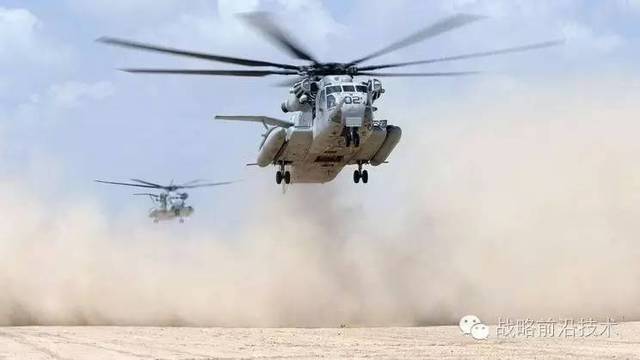
Two US Marine Corps helicopters in Djibouti, 2007. Photo: Commons / US Navy photo (Senior Airman Jamie M. Train)
Sales of arms and military services by the largest arms-producing and military services companies—the SIPRI Top 100—totalled $370.7 billion in 2015 according to new data on the international arms industry released today by SIPRI.
The sales of arms and military services companies in the SIPRI Top 100 have fallen for the fifth consecutive year. However, at only a 0.6 per cent decline, the slight decrease may signal a possible reversal of the downward sales trend observed since 2011.
US companies still way ahead despite falling revenues
Companies based in the United States continue to dominate the Top 100 with total arms sales amounting to $209.7 billion for 2015. Arms sales by US companies in the Top 100 decreased by 2.9 per cent compared with 2014—the fifth consecutive year of decline.
‘Lockheed Martin remains the largest arms producer in the world,’ says Aude Fleurant, Director of SIPRI’s Arms and Military Expenditure Programme. ‘However, US companies’ arms sales are constrained by caps on US military spending, delays in deliveries of major weapon systems and the strength of the US dollar, which has negatively affected export sales.’
Many of the larger US arms-producing companies divested their military services activities after 2010 due to falling demand. A number of the new, smaller companies created by this process have consolidated and have built up sufficient revenue to rank in the Top 100 for 2015; three such companies are CSRA, Engility and Pacific Architects and Engineers.
West European arms sales up in 2015 after falls in 2014
Arms sales by companies in Western Europe listed in the SIPRI Top 100 for 2015 rose by 6.6 per cent in real terms compared with 2014, with total combined revenues from arms sales amounting to $95.7 billion. This increase contrasts with the notable drop in West European companies’ revenues from arms sales recorded between 2013 and 2014.
The combined arms sales of the six French companies listed in the Top 100 totalled $21.4 billion in 2015, a rise of 13.1 per cent compared with 2014, when most of those companies recorded a fall in arms sales. The increase in French companies’ arms sales has acted as an important driver for the recent growth in arms sales in Western Europe.
‘Major arms export deals in 2015, such as those to Egypt and Qatar, have increased French arms companies’ sales,’ says Fleurant. ‘A 67.5 per cent surge in arms sales by Dassault Aviation Group seems to be mainly the result of such exports.’
The three German companies listed in the Top 100 continued to increase their combined sales (by 7.4 per cent) in 2015. Companies in the Top 100 based in the United Kingdom reversed the downward trend recorded in 2014 with a 2.8 per cent rise in their combined arms sales in 2015.
Continued growth in sales by the Russian arms industry
The combined arms sales of the 11 Russian companies in the 2015 Top 100 reached $30.1 billion, representing 8.1 per cent of the total Top 100 arms sales for 2015 and an increase of 6.2 per cent compared with 2014. Ten out of the 11 companies listed have increased their arms sales in 2015.
‘Profiting from the Russian military modernization programme, most of the top Russian companies have increased their arms sales in constant roubles,’ says SIPRI Senior Researcher Siemon Wezeman. ‘However, all Russian companies in the SIPRI Top 100 for 2015 are ranked lower than they were in 2014 because the pace of the growth in their arms sales has slowed.’
South Korea leading the rise of emerging producers in the Top 100
Emerging producers and other established producers account for 9.5 per cent of the Top 100 arms sales for 2015 with a combined total of $34.5 billion.* This represents an increase of 3.0 per cent for other established producers compared with 2014 and a rise of 15.9 per cent for emerging producers. The significant growth in emerging producers’ arms sales is mostly attributable to South Korean companies, which increased sales by 31.7 per cent in 2015.
‘All South Korean companies show higher arms sales in 2015, reflecting their growing capacity to meet the South Korean Ministry of Defense’s demand and their ongoing success in the international market,’ says Wezeman. ‘LIG Nex1 increased its arms sales by 34.7 per cent compared with 2014, and Korea Aerospace Industry’s arms sales rose by 51.7 per cent.’ Poongsan (an ammunition and propellant producer), DSME (a shipbuilder) and Hanwha Thales (a weapon systems producer) were new South Korean entrants to the Top 100 in 2015.
National efforts among the emerging producers to develop their arms industries have shown mixed results in 2015. The combined arms sales of India’s ranked companies grew by 9.3 per cent compared with 2014, while the combined sales of Turkish companies rose by 10.2 per cent. Embraer, the sole Brazilian company in the Top 100, recorded a 28.1 per cent decline in its arms sales in 2015.
The SIPRI Arms Industry Database
The SIPRI Arms Industry Databasewas created in 1989. It contains financial and employment data on arms-producing companies worldwide. Since 1990, SIPRI has published data on the arms sales and employment of the 100 largest of these arms-producing companies in the SIPRI Yearbook.
‘Arms sales’ are defined by SIPRI as sales of military goods and services to military customers, including sales for domestic procurement and sales for export. Changes are calculated in real terms and country comparisons are only for the same companies over different years.
* The ‘emerging producers’ category covers companies located in Brazil, India, South Korea and Turkey. The ‘other established producers’ category covers companies located in Australia, Israel, Japan, Poland, Singapore and Ukraine.
For information and interview requests contact SIPRI Communications Director Stephanie Blenckner(blenckner@sipri.org, +46 8 655 97 47) or Harri Thomas(harri.thomas@sipri.org+46 72 203 58 30).
This is the first of a series of major data set pre-launches in the lead-up to the publication of the next edition of the SIPRI Yearbook. In the first half of 2017, SIPRI will release its international arms transfers data(details of all international sales, transfers and gifts of major weapons in 2016) as well as its world military expenditure data(comprehensive information on global, regional and national trends in military spending). All data will feature in the SIPRI flagship publication SIPRI Yearbook 2017to be published in late 2017.
一网打尽系列文章,请回复以下关键词查看:
创新发展:习近平 | 创新中国 | 创新创业 | 科技体制改革 | 科技创新政策 | 协同创新 | 成果转化 | 新科技革命 | 基础研究 | 产学研 | 供给侧
热点专题:军民融合 | 民参军 | 工业4.0 | 商业航天 | 智库 | 国家重点研发计划 | 基金 | 装备采办 | 博士 | 摩尔定律 | 诺贝尔奖 | 国家实验室 | 国防工业 | 十三五
预见未来:预见2016 |预见2020 | 预见2025 | 预见2030 | 预见2035 | 预见2045 | 预见2050 |
前沿科技:颠覆性技术 | 生物 | 仿生 | 脑科学 | 精准医学 | 基因 | 基因编辑 | 虚拟现实 | 增强现实 | 纳米 | 人工智能 | 机器人 | 3D打印 | 4D打印 | 太赫兹 | 云计算 | 物联网 | 互联网+ | 大数据 | 石墨烯 | 能源 | 电池 | 量子 | 超材料 | 超级计算机 | 卫星 | 北斗 | 智能制造 | 不依赖GPS导航 | 通信 | MIT技术评论 | 航空发动机 | 可穿戴 | 氮化镓 | 隐身 | 半导体 | 脑机接口
先进武器:中国武器 | 无人机 | 轰炸机 | 预警机 | 运输机 | 战斗机 | 六代机 | 网络武器 | 激光武器 | 电磁炮 | 高超声速武器 | 反无人机 | 防空反导 | 潜航器 |
未来战争:未来战争 | 抵消战略 | 水下战 | 网络空间战 | 分布式杀伤 | 无人机蜂群
领先国家:俄罗斯 | 英国 | 日本 | 以色列 | 印度
前沿机构:战略能力办公室 | DARPA | Gartner | 硅谷 | 谷歌 | 华为 | 俄先期研究基金会
前沿人物:钱学森 | 马斯克 | 凯文凯利 | 任正非 | 马云
专家专栏:黄志澄 | 许得君 | 施一公 | 王喜文 | 贺飞 | 李萍 | 刘锋 | 王煜全 | 易本胜 | 李德毅 | 游光荣 | 刘亚威 | 赵文银
全文收录:2016文章全收录 | 2015文章全收录 | 2014文章全收录
其他主题系列陆续整理中,敬请期待……
 编辑推荐
编辑推荐-
四川科技企业近期取得多项突破
-
超三千家企业确认参展进博会
-
济南起步区新增科技型中小企业
-
政策护航 河北民营企业激发新“冀”遇

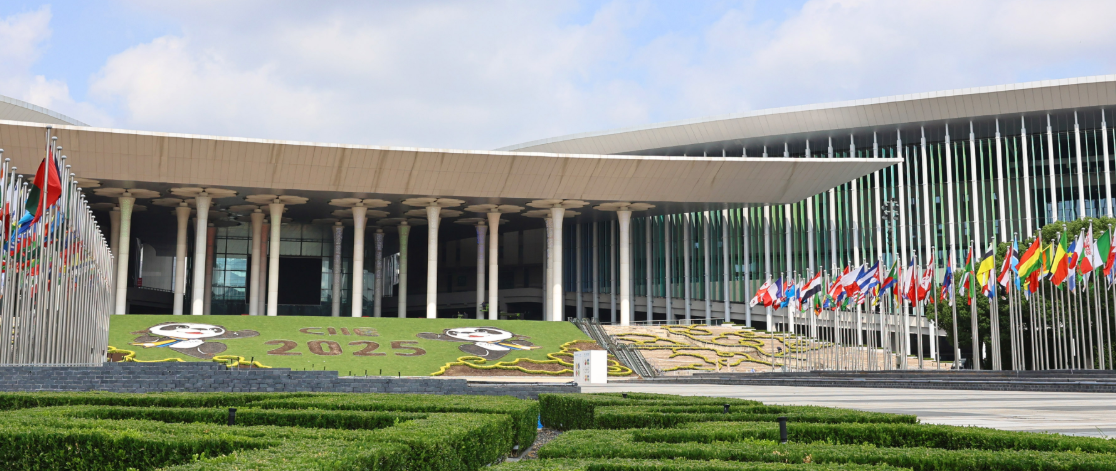
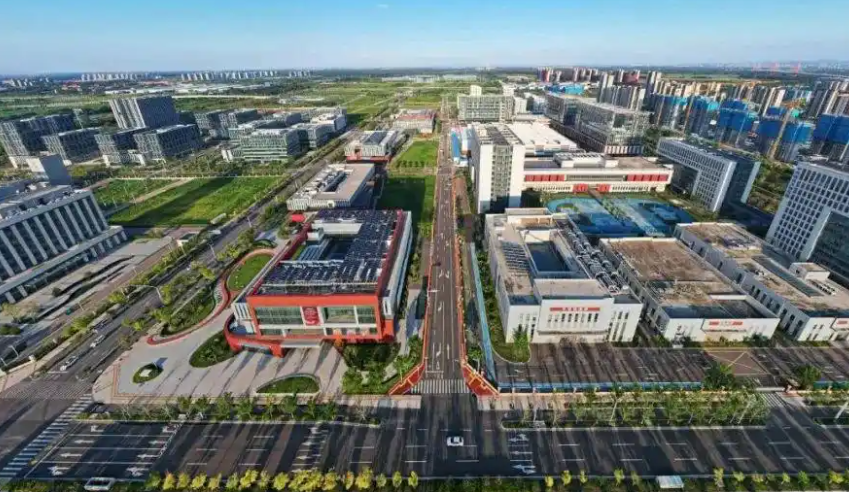
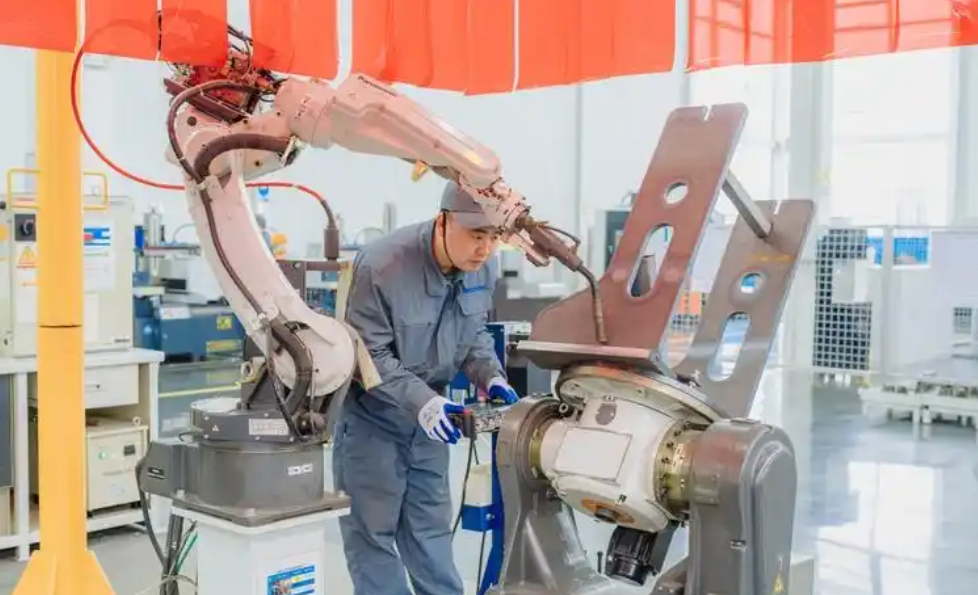
 热点新闻
热点新闻